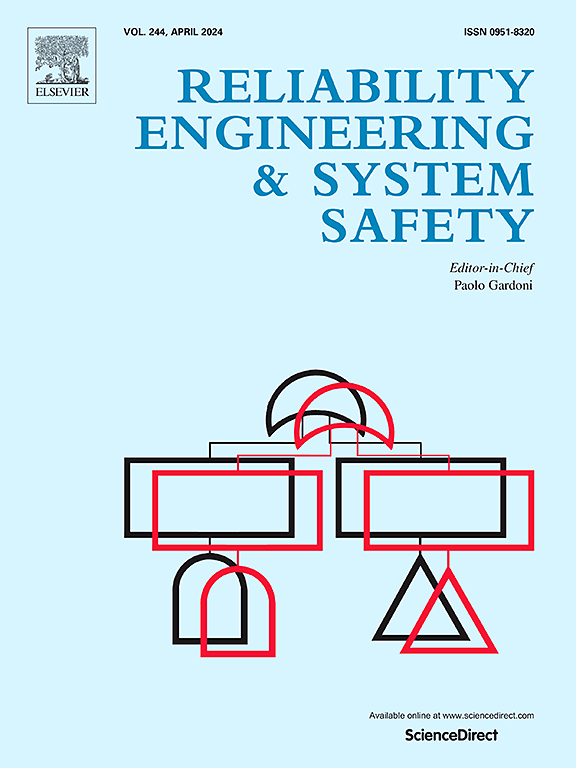考虑资源依赖的交通基础设施和网络弹性模型
IF 9.4
1区 工程技术
Q1 ENGINEERING, INDUSTRIAL
引用次数: 0
摘要
由于基础设施退化和网络功能演变之间复杂的相互依赖关系,交通系统的弹性量化仍然具有挑战性。本研究提出了交通基础设施和网络的概率弹性模型,该模型将资源依赖的半马尔可夫过程与级联失效机制相结合,以解决这一问题。具体来说,与传统的隔离处理物理和功能故障的模型不同,所提出的模型通过级联故障建模明确地将基础设施级脆弱性与网络级流量再分配动态耦合在一起。在功能恢复模型方面,本研究的核心创新点在于改进的半马尔可夫恢复模型,该模型将半马尔可夫过程与贝叶斯更新的资源依赖模型相结合,既解决了恢复策略选择问题,又解决了可用恢复资源对恢复时间分布的影响。此外,给出了弹性模型的建立步骤和基于仿真的算法。然后对现实世界的交通网络进行了案例研究,以说明所提出的弹性模型的适用性。案例分析结果表明,恢复策略的选择导致基础设施级弹性的84%变异和整个网络弹性指标的74%差异,而与最佳可用性相比,严重的资源约束使基础设施级弹性降低了71%。至关重要的是,与功能损失优先级策略相比,传统的基于临界度的分配将网络恢复效率提高了50%。它表明了多重标准的必要性,包括功能损失的严重程度、拓扑重要性和现场施工限制。在方法上,将基础设施物理失效与网络流动力学演化相结合,为城市交通决策提供理论依据。该框架通过实时容量预测和资源策略优化实现自适应恢复,为利益相关者提供可操作的见解。本文章由计算机程序翻译,如有差异,请以英文原文为准。
Resilience modeling of transportation infrastructure and network based on the semi-Markov process considering resource dependency
Resilience quantification for transportation systems remains challenging due to complex interdependencies between infrastructure degradation and network functional evolution. This study presents probabilistic resilience models of transportation infrastructures and networks, which integrate resource-dependent semi-Markov processes with cascading failure mechanisms to address this problem. Specifically, unlike conventional models treating physical and functional failures in isolation, the proposed models explicitly couple infrastructure-level fragility with network-level traffic redistribution dynamics by cascading failure modeling. With respect to the functional recovery modeling, the core innovation of this study lies in the modified semi-Markov recovery model, which integrates the semi-Markov process and the Bayesian-updated resource dependency model to address both recovery strategy selection and the effect of the available recovery resource on the recovery time distribution. Further, the procedure and simulation-based algorithm of the resilience models are provided. A case study is then carried out for a real-world transportation network to illustrate the applicability of the proposed resilience models. Case analysis results demonstrate that recovery strategy selection drives 84% variability in infrastructure-level resilience and 74% divergence in network-wide resilience metrics, while severe resource constraints degrade infrastructure-level resilience by 71% compared to optimal availability. Crucially, conventional criticality-based allocation prolongs network recovery efficiency by 50% versus functionality-loss-prioritized strategies. It indicates the necessity of multi-criteria including functionality loss severity, topological importance, and on-site construction limitations. Methodologically, it unifies infrastructure physics failure with network flow dynamics evolution for urban transport decision-making. The framework enables adaptive recovery via real-time capacity predictions and resource-strategy optimization, providing stakeholders with actionable insights.
求助全文
通过发布文献求助,成功后即可免费获取论文全文。
去求助
来源期刊

Reliability Engineering & System Safety
管理科学-工程:工业
CiteScore
15.20
自引率
39.50%
发文量
621
审稿时长
67 days
期刊介绍:
Elsevier publishes Reliability Engineering & System Safety in association with the European Safety and Reliability Association and the Safety Engineering and Risk Analysis Division. The international journal is devoted to developing and applying methods to enhance the safety and reliability of complex technological systems, like nuclear power plants, chemical plants, hazardous waste facilities, space systems, offshore and maritime systems, transportation systems, constructed infrastructure, and manufacturing plants. The journal normally publishes only articles that involve the analysis of substantive problems related to the reliability of complex systems or present techniques and/or theoretical results that have a discernable relationship to the solution of such problems. An important aim is to balance academic material and practical applications.
 求助内容:
求助内容: 应助结果提醒方式:
应助结果提醒方式:


